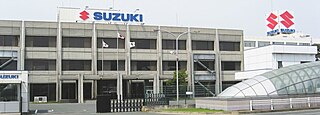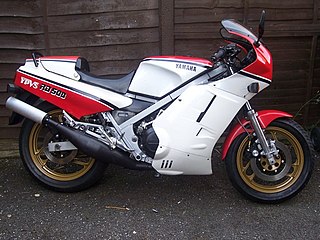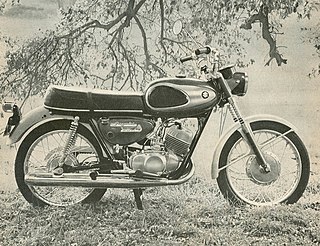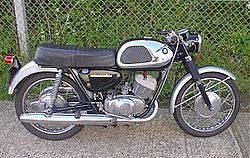
A two-strokeengine is a type of internal combustion engine that completes a power cycle with two strokes of the piston during one power cycle, this power cycle being completed in one revolution of the crankshaft. A four-stroke engine requires four strokes of the piston to complete a power cycle during two crankshaft revolutions. In a two-stroke engine, the end of the combustion stroke and the beginning of the compression stroke happen simultaneously, with the intake and exhaust functions occurring at the same time.

Suzuki Motor Corporation is a Japanese multinational corporation headquartered in Minami-ku, Hamamatsu, Japan. Suzuki manufactures automobiles, motorcycles, all-terrain vehicles (ATVs), outboard marine engines, wheelchairs and a variety of other small internal combustion engines. In 2016, Suzuki was the eleventh biggest automaker by production worldwide. Suzuki has over 45,000 employees and has 35 production facilities in 23 countries, and 133 distributors in 192 countries. The worldwide sales volume of automobiles is the world's tenth largest, while domestic sales volume is the third largest in the country.
RPE RP-V8 is the name of a naturally-aspirated V8 engine series developed by Radical Sportscars in Peterborough, England for use in the SR8 sportscar. The design is loosely based on the 1.3 litres (79.3 cu in) inline-four engine produced by Suzuki for their Hayabusa motorcycle. The company have designed their own cylinder block and use existing Suzuki cylinder heads. The two cylinder banks are inclined at 72-degree angle. Lubrication is provided by a dry sump system. The engine is mated to a purpose-built transaxle designed by Quaife.

The Suzuki GS series was Suzuki Motor Corporation's first full range of 4-stroke powered road motorcycles, having previously almost exclusively manufactured 2-stroke machines. Suzuki had produced the 4-stroke Colleda COX 125cc and 93cc 4-stroke single-cylinder machines in 1955 however the rest of Suzuki's production from 1952 to 1976 had been increasingly sophisticated two-stroke road machines, whose ultimate expression was the 750cc 3-cylinder water-cooled GT750.

Victory Motorcycles was an American motorcycle manufacturer with its final assembly facility in Spirit Lake, Dickinson County, northwestern Iowa, United States. It began production of its vehicles in 1998, and began winding down operations in January 2017 to be succeeded by the revived traditional American motorcycle brand Indian, which is since 2011 owned by parent company Polaris Industries.
The GSX Series is Suzuki's range of sport touring motorcycles powered by four-valve per cylinder four-stroke engines. The first GSX models were introduced in 1980 and represented the next step in Suzuki's four-stroke road bike range after the two-valve GS Series.

A motorcycle engine is an engine that powers a motorcycle. Motorcycle engines are typically two-stroke or four-stroke internal combustion engines, but other engine types, such as Wankels and electric motors, have been used.

The Yamaha RD500LC is a high-performance, two-stroke sports motorcycle, also known as the RZ500 in Canada and Australia. A lightened but detuned version known as the RZV500R was developed for the Japanese home market. Strict United States Environmental Protection Agency regulations meant that the RZ500 was not available for sale in that country. Produced for a short period between 1984 and 1986 it has become a sought after collector's machine.

The Suzuki T series was a series of motorcycle manufactured by Suzuki that ran from approximately 1963 through 1977 in various engine displacements between 90 and 500 cc.

The Suzuki TU250—marketed also as the TU250X, ST250 and ST250 E-Type—is a single-cylinder, air-cooled motorcycle launched by Suzuki in 1994 as a lightweight street bike.

The GT series is a series of two-stroke chain drive motorcycles manufactured and marketed by Suzuki for model years 1972-1977, with a range of engine capacities and cylinder counts. Certain markets received the GT380 until model year 1980.

The Kawasaki A1 Samurai is a 250 cc (15 cu in) standard class Kawasaki motorcycle which was sold from 1967 through 1971.

The A100 is a motorcycle produced by Suzuki Motor Corporation starting in 1966.

The Suzuki T250, also known as the Suzuki Hustler is a 247 cc (15.1 cu in), two-stroke, twin-cylinder motorcycle produced by the Japanese Suzuki company between 1969 and 1972. The model was developed from the earlier T20 and was one of the models that contributed to Suzuki's success in the early 1970s.

The Suzuki GT250, also known as the Suzuki Hustler in the US is a 247 cc (15.1 cu in), two-stroke, twin-cylinder motorcycle produced by the Japanese Suzuki company between 1971 and 1981. The model was developed from the earlier T250, and was one of the best selling motorcycles in its class. For 1978 the bike was redesign and marketed as the GT250 X7. The X7 was capable of reaching 100 mph (160 km/h) in favourable conditions. The model range was discontinued in 1981 in favour of Suzuki's four stroke models, and the X7 was developed into the RG250 Gamma.

The Suzuki T350, also known as the Suzuki Rebel is a 315 cc (19.2 cu in), two-stroke, twin-cylinder motorcycle produced by the Japanese Suzuki company between 1969 and 1972. The model was based T305 and used an enlarged version of the T305 engine, which itself was an enlargement of the T20 unit. It was the fastest production 350 at the time. In 1972 a T350 won both the 500 class and was overall winner of the Australian Castrol Six Hour Production race at Amaroo Park but was subsequently disqualified. The model was dropped when the T380 triple was introduced in 1972.
The Suzuki T90, also known as the Suzuki Wolf is a 89 cc (5.4 cu in), two-stroke, twin-cylinder motorcycle produced by the Japanese Suzuki company between 1969 and 1972. The model was the only twin-cylinder machine in the class at the time. The T90 was radically styled and except for the engine size, the model was the same as the Suzuki T125.

The Suzuki T200, also known as the Suzuki Invader and the X5 in the US is a 196 cc (12.0 cu in), two-stroke, twin-cylinder motorcycle produced by the Japanese Suzuki company between 1967 and 1971. The model was a scaled down version of the Suzuki T20.

The Suzuki T500, variously known as the Suzuki T500/Five, Suzuki Charger, Suzuki Cobra and the Suzuki Titan during its model life, is a 492 cc (30.0 cu in), two-stroke, twin-cylinder motorcycle produced by the Japanese Suzuki company between 1968 and 1975. The model was developed as a larger version of the Suzuki T20 which was intended to compete with the large-capacity British twins in the American market. When itroduced it was Suzuki's largest displacement machine. Overengineering of the engine led to the bike gaining a reputation for reliability, and being virtually bulletproof. A total of over 100,000 units were sold during the model's production.


















